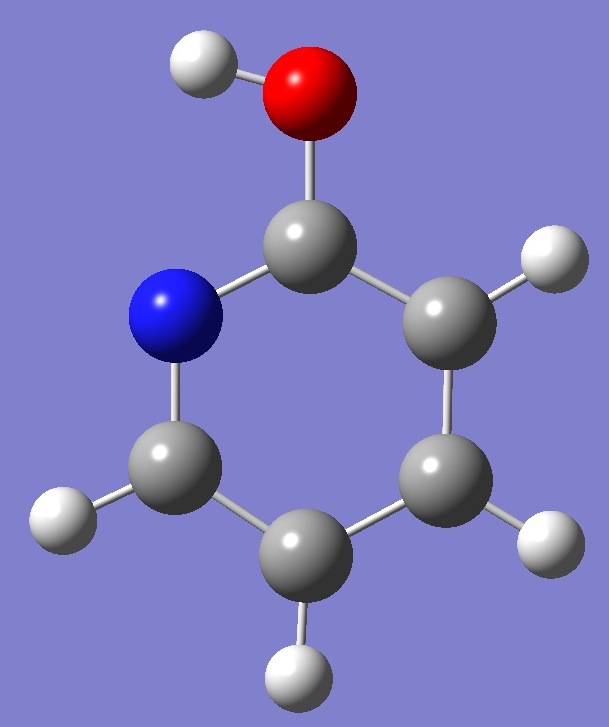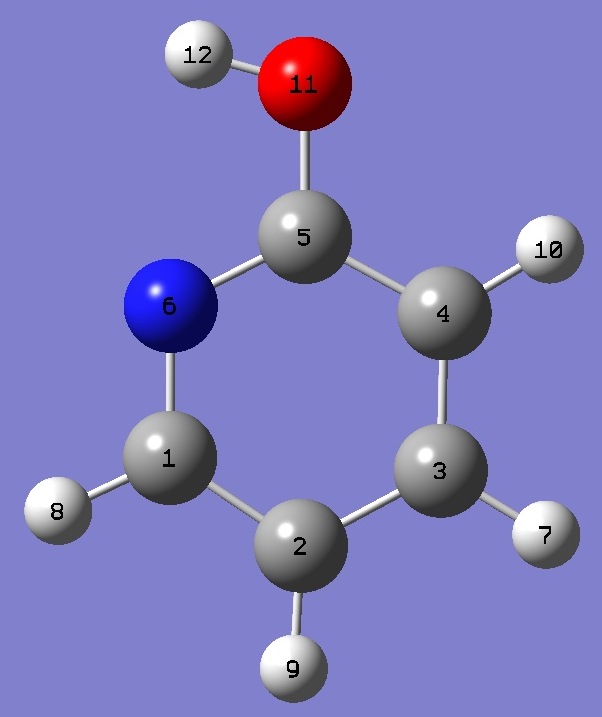|
|
|
|
|
|
|
|
|
|
|
|
|
|
|
|
|
|
|
|
|
2-Hydroxypyridine |

|
|
|
|
|
|
|
|
|
|
|
|
|
|
|
|
|
|
|
|
|
|
|
|
|
|
|
|
|
|
|
|
|
|
|
Nitrogen and Deuterium
|
|
|
Nuclear
Quadrupole Coupling Constants |
|
|
in 2-Hydroxypyridine
|
|
|
|
|
|
|
|
|
|
|
|
|
|
|
|
|
|
|
|
|
|
|
|
|
|
|
|
|
|
|
|
|
Nitrogen and Deuterium (O-D) nqcc's in 2-hydroxypyridine were determined by Tanjaroon et al. [1]. |
|
|
|
|
|
|
|
|
|
|
|
|
Calculation of the nqcc's was made here on molecular structures derived by B3P86/6-31G(d,p) and B3P86/6-31G(3d,3p)
optimizations. Calculated and experimental nqcc's are compared in
Tables 1 - 3. Structure parameters are given in Table 4,
rotational constants in Table 5. |
|
|
|
|
|
|
|
|
|
|
|
|
In Tables 1 - 3, subscripts a,b,c refer to the
principal axes of the inertia tensor; x,y,z to the principal axes
of the nqcc tensor.
Ø (degrees) is the angle between its subscripted
parameters. ETA = (Xxx - Xyy)/Xzz. |
|
|
|
|
|
|
|
|
|
|
|
|
RMS is the root mean square
difference between calculated and experimental diagonal nqcc's
(percentage of the average of the magnitudes of the experimental
nqcc's). RSD is the calibration residual standard deviation of
the B3PW91/6-311+G(df,pd) model for calculation of nitrogen nqcc's; and
of the B3LYP/6-31G(df,3p) model for calculation of the deuterium nqcc's. |
|
|
|
|
|
|
|
|
|
|
|
|
|
|
|
|
|
|
|
|
|
|
| |
|
|
|
|
|
|
|
|
|
Table 1. 14N nqcc's
in 2-Hydroxypyridine (MHz). Calculation was made
on (1) B3P86/6-31G(d,p) and (2) B3P86/6-31G(3d,3p) optimized structures. |
|
| |
|
|
|
|
|
|
|
|
|
|
|
Calc. (1)
|
|
Calc. (2) |
|
Expt. [1] |
|
| |
|
|
|
|
|
|
|
|
|
Xaa |
- |
0.086 |
- |
0.094 |
- |
0.076(11) |
|
|
Xbb |
- |
2.161 |
- |
2.174 |
- |
2.283(6) |
|
|
Xcc |
|
2.246 |
|
2.268 |
|
2.359(6) |
|
|
|Xab| |
|
2.733 |
|
2.729 |
|
|
|
|
|
|
|
|
|
|
|
|
|
RMS |
|
0.096 (6.1 %) |
|
0.082 (5.2 %) |
|
|
|
|
RSD |
|
0.030 (1.3 %) |
|
0.030 (1.3 %) |
|
|
|
|
|
|
|
|
|
|
|
|
|
Xxx |
|
1.800 |
|
1.787 |
|
|
|
|
Xyy |
|
2.246 |
|
2.268 |
|
|
|
|
Xzz |
- |
4.047 |
- |
4.055 |
|
|
|
|
ETA |
|
0.110 |
|
0.119 |
|
|
|
|
Øz,a |
|
55.39 |
|
55.43 |
|
|
|
|
Øa,bi a |
|
56.54 |
|
56.56 |
|
|
|
|
Øz,bi |
|
1.15 |
|
1.12 |
|
|
|
|
|
|
|
|
|
|
|
|
|
|
|
|
|
|
|
|
|
|
|
|
|
a "bi" is the bisector of the CNC angle. |
|
|
|
|
|
|
|
|
|
|
|
|
|
|
|
|
|
|
|
|
|
|
| |
|
|
|
|
|
|
|
|
|
Table 2. 14N nqcc's
in 2-Deuteriohydroxypyridine (MHz). Calculation was made
on (1) B3P86/6-31G(d,p) and (2) B3P86/6-31G(3d,3p) optimized structures. |
|
| |
|
|
|
|
|
|
|
|
|
|
|
Calc. (1)
|
|
Calc. (2) |
|
Expt. [1] |
|
| |
|
|
|
|
|
|
|
|
|
Xaa |
- |
0.200 |
- |
0.208 |
- |
0.1465(4) |
|
|
Xbb |
- |
2.046 |
- |
2.060 |
- |
2.2045(4) |
|
|
Xcc |
|
2.246 |
|
2.268 |
|
2.3510(4) |
|
|
|Xab| |
|
2.774 |
|
2.770 |
|
|
|
|
|
|
|
|
|
|
|
|
|
RMS |
|
0.114 (7.2 %) |
|
0.102 (6.5 %) |
|
|
|
|
RSD |
|
0.030 (1.3 %) |
|
0.030 (1.3 %) |
|
|
|
|
|
|
|
|
|
|
|
|
|
|
|
|
|
|
|
|
|
|
|
|
|
|
|
|
|
|
|
|
|
|
|
| |
|
|
|
|
|
|
|
|
|
Table 3. 2H nqcc's
in 2-Deuteriohydroxypyridine (kHz). Calculation was made
on (1) B3P86/6-31G(d,p) and (2) B3P86/6-31G(3d,3p) optimized structures. |
|
| |
|
|
|
|
|
|
|
|
|
|
|
Calc. (1)
|
|
Calc. (2) |
|
Expt. [1] |
|
| |
|
|
|
|
|
|
|
|
|
Xaa |
|
- 70.3 |
|
- 70.5 |
|
- 25.0(9) |
|
|
Xbb |
|
221.4 |
|
223.8 |
|
169.9(4) |
|
|
Xcc |
|
151.1 |
- |
153.3 |
- |
144.9(4) |
|
|
|Xab| |
|
126.1 |
|
129.4 |
|
|
|
|
|
|
|
|
|
|
|
|
|
RMS |
|
39.8 (35 %) |
|
40.1 (36 %) |
|
|
|
|
RSD |
|
1.1 (0.86 %) |
|
1.1 (0.86 %) |
|
|
|
|
|
|
|
|
|
|
|
|
|
Xxx |
- |
117.3 |
- |
119.3 |
|
|
|
|
Xyy |
- |
151.1 |
- |
153.3 |
|
|
|
|
Xzz |
|
268.4 |
|
272.6 |
|
|
|
|
ETA |
|
0.126 |
|
0.124 |
|
|
|
|
Øz,a |
|
69.58 |
|
69.33 |
|
|
|
|
Øa,OH |
|
71.44 |
|
71.11 |
|
|
|
|
Øz,OH |
|
1.86 |
|
1.78 |
|
|
|
|
|
|
|
|
|
|
|
|
|
|
|
|
|
|
|
|
|
|
|
|
|
| |
|
|
|
|
| Table 4.
2-Hydroxypyridine. Selected structure parameters (Å
and degrees). Complete structures are given here in Z-matrix format. |
| |
|
|
|
|
| Click on image |
ropt (1) B3P86/6-31G(d,p) |
| to enlarge. |
ropt (2) B3P86/6-31G(3d,3p) |
| |
|
|
|
|
|
|
ropt (1) |
ropt (2) |

|
|
|
|
| C(1)N |
1.3380 |
1.3360 |
| NC(5) |
1.3272 |
1.3249 |
| C(1)NC(5) |
117.45 |
117.40 |
| CO |
1.3465 |
1.3464 |
| OH |
0.9691 |
0.9670 |
| NC(5)C(4) |
124.11 |
124.12 |
| COH |
105.49 |
105.79 |
| |
|
|
|
|
| The "tautomeric" hydrogen atom is rs
= 2.653(2) Å from the center of mass of the molecule [1].
On the B3P86/6-31G(d,p) structure, it is 2.6450 Å; and
on the B3P86/6-31G(3d,3p) structure, 2.6460 Å. |
|
|
|
|
|
|
|
|
|
|
|
|
|
|
| |
|
|
|
|
| Table 5. 2-Hydroxypyridine. Rotational Constants (MHz). Normal Species. |
| |
|
|
|
|
|
ropt (1) = B3P86/6-31G(d,p) optimization. |
|
ropt (2) = B3P86/6-31G(3d,3p) optimization. |
|
|
|
|
|
|
|
Calc. ropt (1) |
Calc. ropt (2) |
Expt. [1] |
|
|
|
|
|
|
A |
5848.7 |
5868.2 |
|
|
B |
2780.0 |
2787.3 |
|
|
C |
1884.3 |
1889.7 |
|
|
|
|
|
|
|
|
|
|
|
|
|
|
|
|
|
|
|
|
|
|
|
|
[1] C.Tanjaroon, R.Subramanian, C.Karunatilaka, and S.G.Kukolich, J.Phys.Chem. A 108,9531(2004). |
|
|
|
|
|
|
|
|
|
|
|
|
L.D.Hatherley, R.D.Brown, P.D.Godfrey, A.P.Pierlot, W.Caminati,
D.Damiani, S.Melendri, and L.B.Favero, J.Phys.Chem. 47,46(1993).
|
|
|
|
|
|
|
|
|
|
|
|
|
|
|
|
|
|
|
|
|
|
|
3-Hydroxypyridine |
4-Hydroxypyridine |
|
|
|
|
Pyridine |
2-Pyridone |
Quinoline |
|
Formic Acid |
2-Methylpyridine
|
Isoquinoline |
|
|
|
|
|
|
|
|
|
|
|
|
|
|
|
|
|
|
|
|
|
|
Table of Contents |
|
|
|
|
|
Molecules/Nitrogen |
|
|
|
|
|
|
|
|
|
|
|
|
|
|
|
|
|
|
|
|
|
|
|
|
|
|
|
|
|
|
2OHPyridine.html |
|
|
|
|
|
|
Last
Modified 1 Oct 2007 |
|
|
|
|
|
|
|
|
|
|

